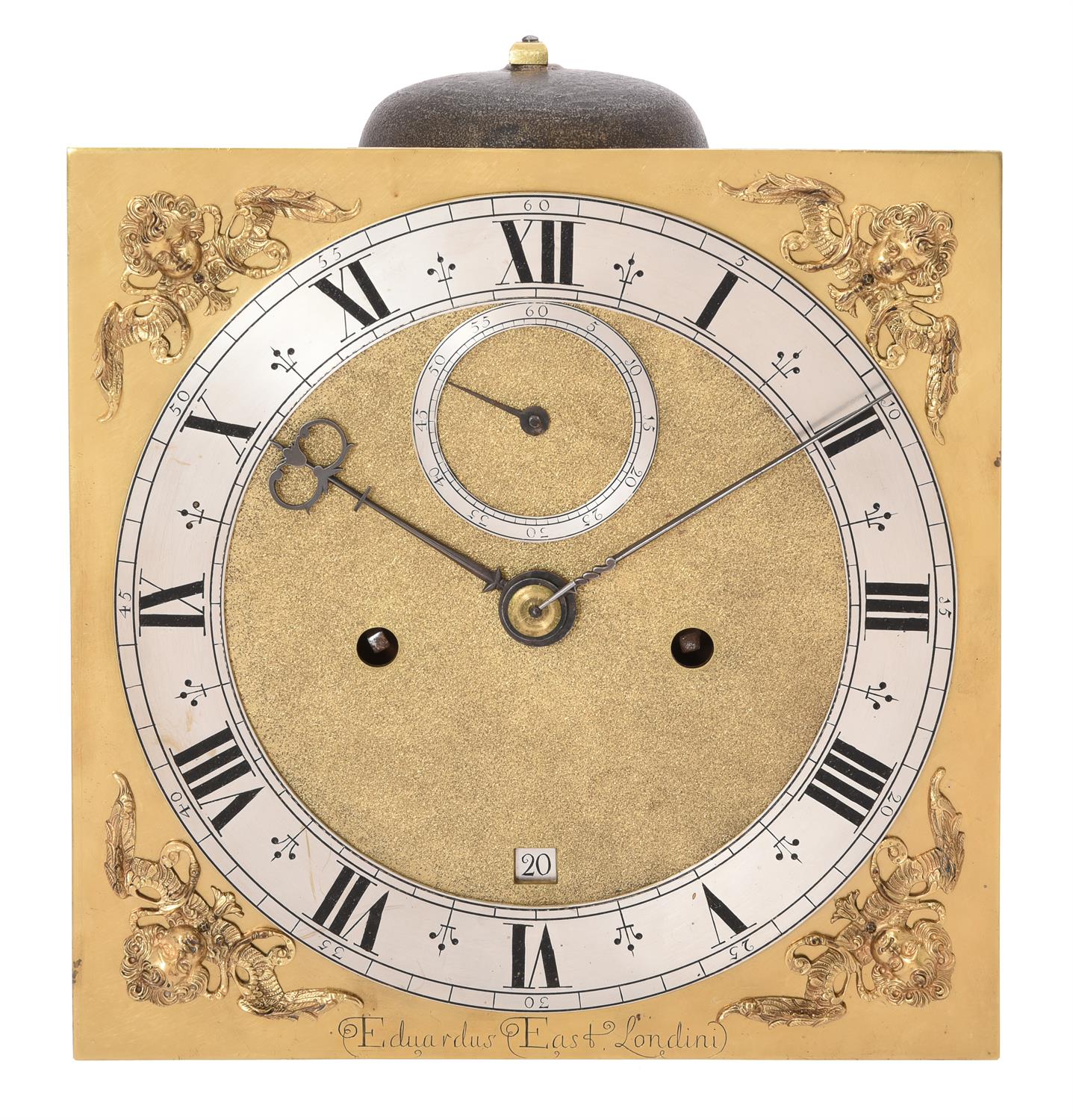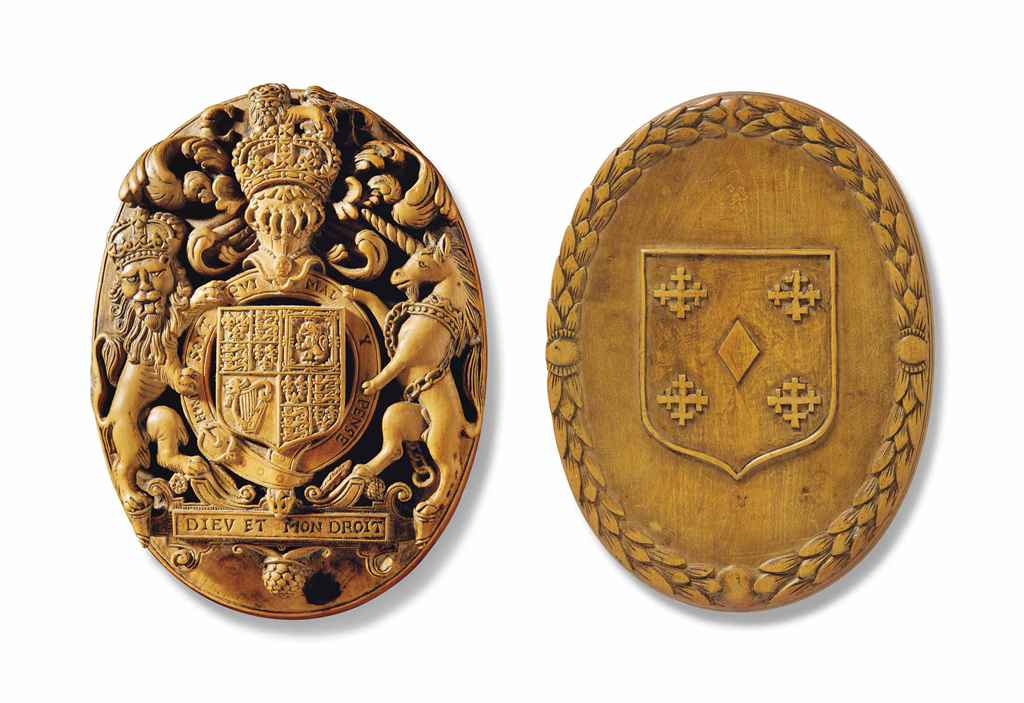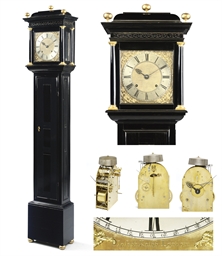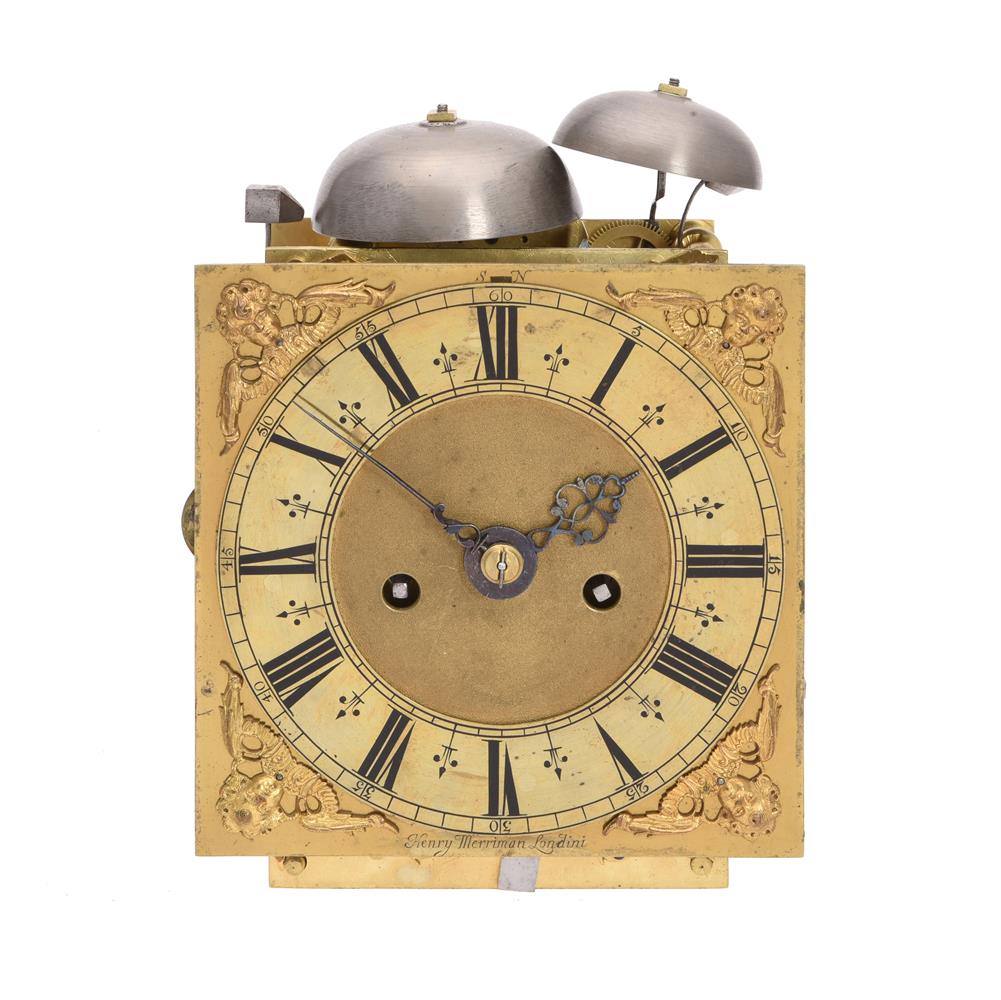A Fine Charles II brass lantern clock Thomas Wheeler, London, circa 1685 The posted countwheel bell-striking movement now converted to anchor escapement with long pendulum, the dial engraved with continuous band of scrolling flowering tulip foliage around vacant centre formerly fitted with an alarm disc, with original iron hand and applied Roman numeral chapter ring with stylised fleur-de-lys half hour markers and leafy infill to angles, the standard London third period 'Lothbury' frame with column turned corner posts beneath engraved and pierced dolphin pattern frets signed Tho: Wheeler neare ye french Church to lower front margin between vase turned finials and with domed bell bearer above, the sides with original plain brass side doors, on turned ball feet, (alarm removed), 40cm (15.75ins) high; with a later oak wall bracket. Provenance: Purchased by the vendor from Philips Fine Art Auctioneers in 1978 having belonged to the former owner for around 40 years. Illustrated in Cescinky, Herbert & Webster, Malcolm R. English Domestic clocks page 61 (fig. 36) where it is described as being in the possession of Percival Griffiths Esq. Thomas Wheeler is recorded in Loomes, Brian LANTERN CLOCKS & Their Makers as apprenticed in 1648 to Nicholas Coxeter and gaining his freedom of the Clockmakers' Company in 1656. He became Assistant from 1674, Warden from 1680 and was appointed Master in 1684. His last record of attendance was in 1694 and is thought to have died between 1695 and 1701, when his widow received charity from the Company. The introduction of the verge escapement with short bob pendulum to lantern clocks presented difficulties to makers with regards to the positioning of the alarm mechanism. Traditionally, on balance wheel clocks, the alarm was placed to the rear on the outside of the backplate. However on a pendulum clock this position is likely to conflict with the preferred position of the pendulum. One solution to the problem was to relocate the pendulum within the frame, either at the rear or between the trains in the centre of the movement; with latter being the option preferred by many London makers during the 1680's including John Ebsworth, Richard Ames as well as Thomas Wheeler. Another option was to relocate the alarm within the frame to the rear, this solution was preferred by West Country makers such as Edward Webb of Chew Stoke. The current lot, however, takes a novel approach with alarm being originally mounted halfway through the backplate, with the pulley positioned within the frame (holes for the lines to exit are still visible in the bottom plate) and the crownwheel and hammer assembly positioned outside. The alarm would have been fitted on a pivot post fitted to a curved iron bridge which would have been riveted to the backplate. The current lot has a relatively early and neat conversion to anchor escapement but with an unusually large escape wheel of 52 teeth, pallets spanning 12 teeth, and pendulum with effective length of 46.5 inches. This layout results in a pendulum beating slower than a standard seconds period pendulum and with very small amplitude. The most logical reason for this unusual arrangement is that the clock was to be housed in a tall narrow 'longcase' at the time of conversion, this would also probably account for the hanging hoop and spurs being removed at that time. IMPORTANT NOTES REGARDING THE CATALOGUING OF CLOCKS Movements, dials and cases: movements and dials are described as relating to the cases in which they are housed in one of the following three ways: the case.... we are of the opinion that the movement and dial started life in the current case. in a case... we are of the opinion that the movement and dial are in a case of correct period and type (and may well be original to the movement and dial), however there is evidence to suggest that they may not have started out life together. now in a case... we are of the opinion that the movement and dial are no longer in the origi
A Fine Charles II brass lantern clock Thomas Wheeler, London, circa 1685 The posted countwheel bell-striking movement now converted to anchor escapement with long pendulum, the dial engraved with continuous band of scrolling flowering tulip foliage around vacant centre formerly fitted with an alarm disc, with original iron hand and applied Roman numeral chapter ring with stylised fleur-de-lys half hour markers and leafy infill to angles, the standard London third period 'Lothbury' frame with column turned corner posts beneath engraved and pierced dolphin pattern frets signed Tho: Wheeler neare ye french Church to lower front margin between vase turned finials and with domed bell bearer above, the sides with original plain brass side doors, on turned ball feet, (alarm removed), 40cm (15.75ins) high; with a later oak wall bracket. Provenance: Purchased by the vendor from Philips Fine Art Auctioneers in 1978 having belonged to the former owner for around 40 years. Illustrated in Cescinky, Herbert & Webster, Malcolm R. English Domestic clocks page 61 (fig. 36) where it is described as being in the possession of Percival Griffiths Esq. Thomas Wheeler is recorded in Loomes, Brian LANTERN CLOCKS & Their Makers as apprenticed in 1648 to Nicholas Coxeter and gaining his freedom of the Clockmakers' Company in 1656. He became Assistant from 1674, Warden from 1680 and was appointed Master in 1684. His last record of attendance was in 1694 and is thought to have died between 1695 and 1701, when his widow received charity from the Company. The introduction of the verge escapement with short bob pendulum to lantern clocks presented difficulties to makers with regards to the positioning of the alarm mechanism. Traditionally, on balance wheel clocks, the alarm was placed to the rear on the outside of the backplate. However on a pendulum clock this position is likely to conflict with the preferred position of the pendulum. One solution to the problem was to relocate the pendulum within the frame, either at the rear or between the trains in the centre of the movement; with latter being the option preferred by many London makers during the 1680's including John Ebsworth, Richard Ames as well as Thomas Wheeler. Another option was to relocate the alarm within the frame to the rear, this solution was preferred by West Country makers such as Edward Webb of Chew Stoke. The current lot, however, takes a novel approach with alarm being originally mounted halfway through the backplate, with the pulley positioned within the frame (holes for the lines to exit are still visible in the bottom plate) and the crownwheel and hammer assembly positioned outside. The alarm would have been fitted on a pivot post fitted to a curved iron bridge which would have been riveted to the backplate. The current lot has a relatively early and neat conversion to anchor escapement but with an unusually large escape wheel of 52 teeth, pallets spanning 12 teeth, and pendulum with effective length of 46.5 inches. This layout results in a pendulum beating slower than a standard seconds period pendulum and with very small amplitude. The most logical reason for this unusual arrangement is that the clock was to be housed in a tall narrow 'longcase' at the time of conversion, this would also probably account for the hanging hoop and spurs being removed at that time. IMPORTANT NOTES REGARDING THE CATALOGUING OF CLOCKS Movements, dials and cases: movements and dials are described as relating to the cases in which they are housed in one of the following three ways: the case.... we are of the opinion that the movement and dial started life in the current case. in a case... we are of the opinion that the movement and dial are in a case of correct period and type (and may well be original to the movement and dial), however there is evidence to suggest that they may not have started out life together. now in a case... we are of the opinion that the movement and dial are no longer in the origi















Testen Sie LotSearch und seine Premium-Features 7 Tage - ohne Kosten!
Lassen Sie sich automatisch über neue Objekte in kommenden Auktionen benachrichtigen.
Suchauftrag anlegen